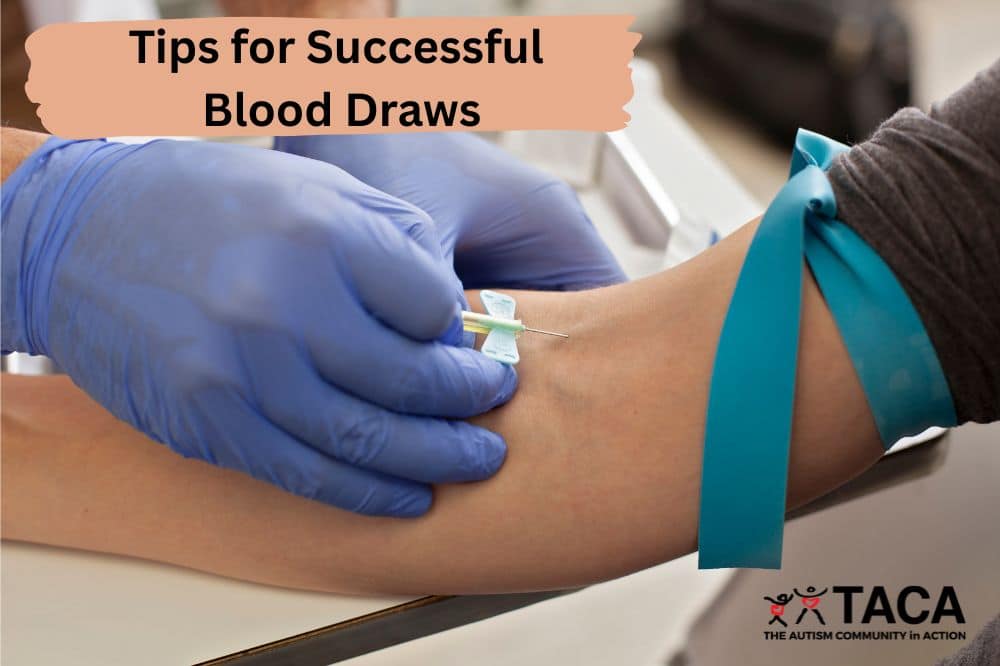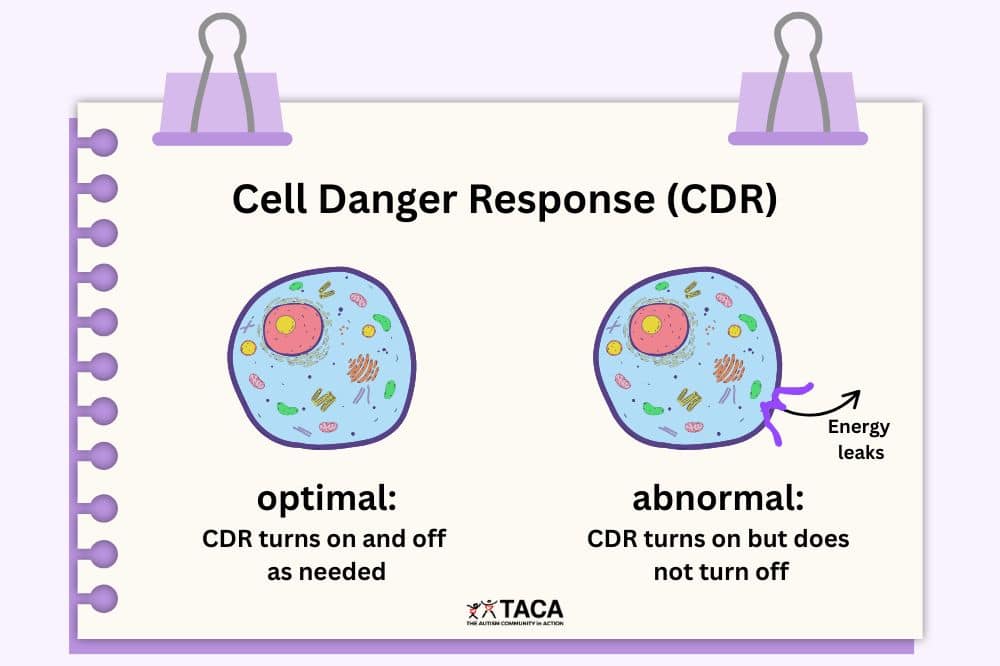Special Education: IEP Tips

All contents of this resource were created for informational purposes only and are not intended to be a substitute for professional advice, diagnosis, or treatment. Always seek the advice of your physician, therapist, or other qualified health providers with any questions or concerns you may have.
An Individualized Education Program (IEP) is the foundation of your child’s education. Many parents feel overwhelmed and anxious about these meetings, but it doesn’t have to be this way. Below, you will find IEP tips to help you successfully navigate the Special Education process, including:
- Who is included on your child’s IEP Team
- Tips for working with the IEP team
- What to do before, during, and after IEP meetings to help maximize your child’s services
Before we begin, let’s cover some basics about special education. The Individuals with Disabilities Education Act (IDEA) is a federal special education law that provides rights and protections to children with disabilities and their parents/guardians. Specifically, IDEA requires that public schools:
- Find and evaluate kids with disabilities at no extra cost to families.
- Provide eligible children with disabilities:
- Early intervention services (ECI),
- A free appropriate public education (FAPE), and
- Special education and related services through an Individualized Education Program (IEP).
While IDEA lays out what every state must do for students with disabilities, it leaves room for interpretation and additional laws within each state. Because of this, you should always confirm your state’s particular special education laws and mandates. Here is a website that can help you find information and support specific to your state.
The IEP Team
A team will create your child’s Individualized Education Program. This team includes the following members:
- You. Yes, you! As the parent, you are an essential member of the IEP team.
- General Education Teacher
- Special Education Teacher
- Local Education Agency Representative (LEA) – usually a principal or special education supervisor
- Psychologist (if evaluations are being discussed)
- Related Service Providers (OT, Speech, PT) and other individuals with knowledge about your child
- Your child (when appropriate and/or they reach transition age)
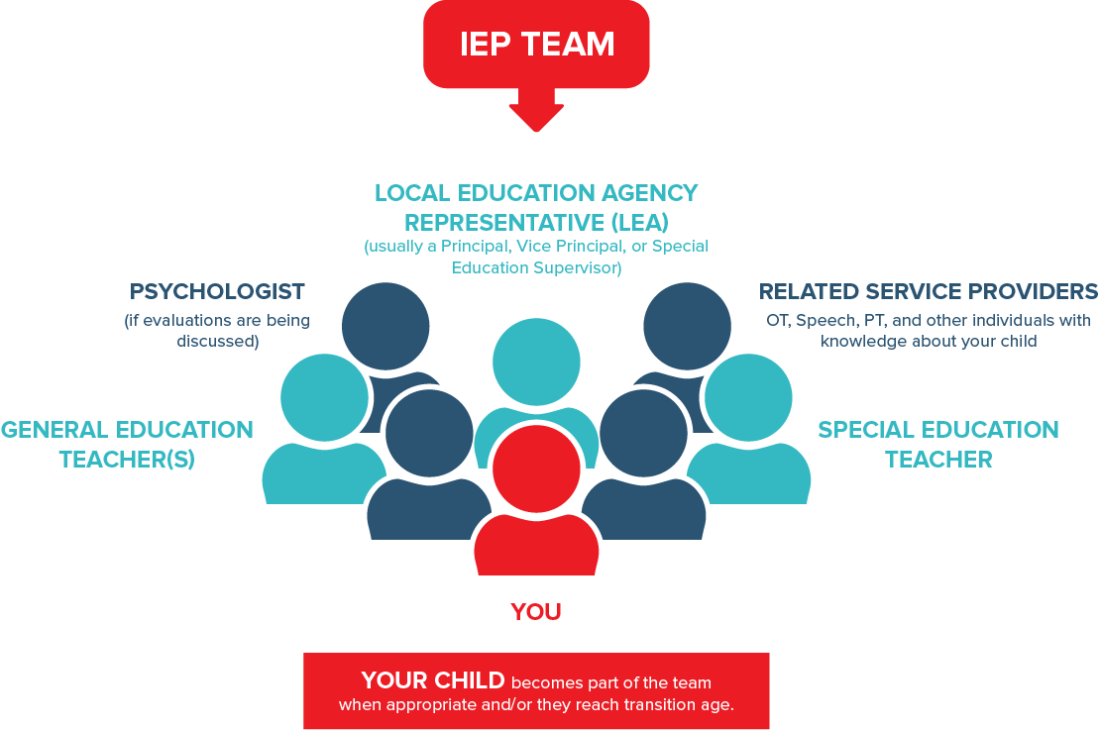
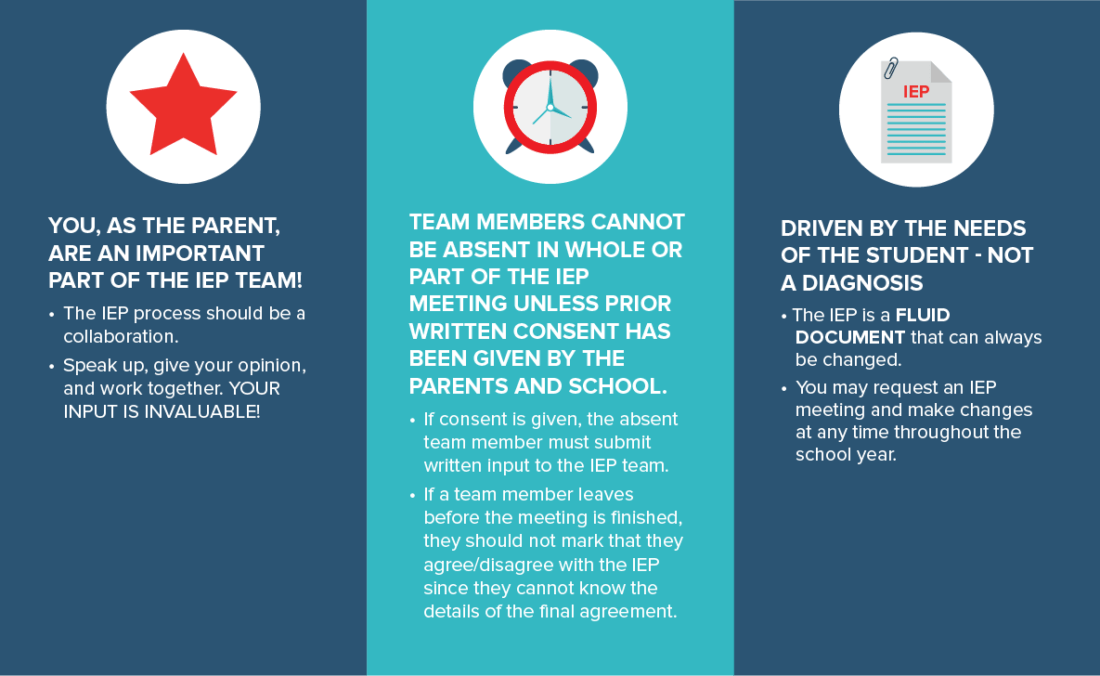
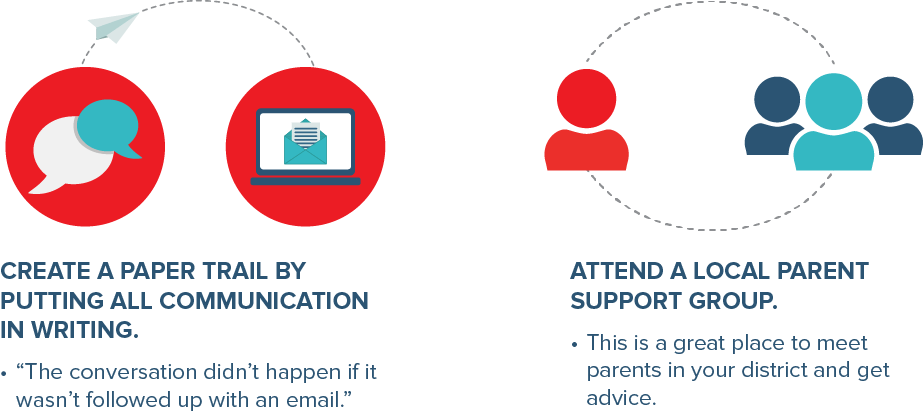
Tips for Working with the IEP Team
The following tips/information will help you become a confident and effective member of your child’s IEP team:
- Understand that the IEP process should be a collaboration. Speak up, give your opinion, and work together. Your input is invaluable!
- Know that team members cannot be absent in whole or part of the IEP meeting unless the parents and school have given prior written consent.
- If consent is given, the absent team member must submit written input to the IEP team.
- Likewise, if a team member leaves before the meeting is over, they should not mark that they agree/disagree with the IEP since they cannot know the details of the final agreement.
- Recognize that an IEP is a fluid document driven by the student’s needs–not the diagnosis.
- This means that it can always be changed! In fact, you may request an IEP meeting and make changes at any time throughout the year.
- Create a paper trail by putting all communication in writing. When you have a face-to-face conversation with a teacher or service provider, follow that up with an email documenting what was discussed.
- For example, “Teacher, thank you for informing me at school pick-up today, Wednesday, April 14, 2021, that my child is continuing to struggle with paying attention during math instruction…”
- Consider attending a local parent support group. This is a great place to meet parents in your district and get advice.
Before the Meeting
When it comes to IEP meetings, a little preparation goes a long way. Here are some IEP tips to help you effectively prepare for your next meeting.
Review the Current IEP, Draft IEP, and Present Levels of Performance
First, make a copy of your child’s current IEP and carefully go over it. Take notes and use a highlighter. When reviewing your child’s current IEP, be sure to:
- Evaluate if your child has met their current goals.
- Go over the data reports you’ve received from the school. If you don’t have data, ask for it (in writing).
- Review your child’s accommodations.
- Do any need to be taken out or added?
- Do any need to be rewritten so they’re easy for new teachers, aides, and therapists to understand?
Then, at least a week before the meeting, request a copy of the draft IEP. Go over it carefully and make notes, paying particular attention to your child’s:
- Present Levels of Performance (PLOP, PLAAFP, or PLP) describes how your child functions academically and socially at school with detailed information about their current strengths, abilities, and weaknesses.
- The IEP team uses information from the PLOP as a baseline to create your child’s goals and accommodations.
- In other words, the PLOP drives the IEP. Therefore, if you want an area addressed with goals in the IEP, there needs to be a Present Level documented.
- The IEP team uses information from the PLOP as a baseline to create your child’s goals and accommodations.
- Proposed goals. When reviewing new goals, consider the following:
- Are they SMART (Specific, Measurable, Achievable, Realistic, Timely)?
- Are they too vague? If a new teacher from a different school or district were to look at them, would they understand what is being taught?
- What setting(s) will goals will be measured in?
- How will data be taken and reported on each goal?
Provide a Parent Input Letter and Copies of Private Evaluations
After reviewing your child’s current IEP, draft IEP, and PLOP, send an email to everyone on the IEP team with your input. When writing your parent input letter, be sure to include any concerns, goals you have for your child, and anything else you want to discuss at the meeting. Bring a signed, hard-copy of this letter to the meeting with you to attach to the IEP.
Additionally, send any private evaluations to the team a week in advance so they have time to read them.
Make Sure All IEP Team Members Can Attend the Meeting
First and foremost, schedule time off from work so you can attend the meeting, requesting Family Medical Leave Act (FMLA) if needed.
Next, verify people with authority will be in attendance. Consider your IEP meeting topics and make sure that your LEA representative has the authority to make decisions pertaining to them. For example:
- If you have a child who struggles with verbal communication, teachers and staff need training on how to use an Alternative and Augmentative Communication (AAC) device. Therefore, an AAC Specialist or an Assistive Technology (AT) Specialist should be at the meeting to discuss details about when and how this training will occur.
- If you are discussing an out-of-district placement, a principal cannot authorize that placement change.
Also, consider inviting a support person to attend the meeting with you. Or, if needed, bring an advocate or attorney with you. If you decide to bring someone with you, inform the team at least 24 hours before the meeting.
Pack Your Bag The Night Before The Meeting
Finally, pack your bag the night before the meeting, making sure it contains the following items:
- Signed, hard-copy of the parent input you emailed to the school (see above).
- Notebook with plenty of room to take notes.
- Audio recording device/app to record the meeting if your state allows:
- Give at least 24 hours’ notice to the school that you intend to record the meeting.
- You can send the audio file to an online transcription company to have a hard copy created to be attached to the IEP.
During the Meeting
Below are tips to help you become an active and confident member during IEP meetings.
Understand Your Child’s Rights
Request that the Procedural Safeguards be explained to you at the beginning of the meeting. Ask questions. Make sure you understand your child’s rights.
Ask Questions and Seek Clarification
Special education professionals can use jargon and acronyms that you are not familiar with. Asking questions shows confidence and lets the team know that you are actively listening. Use phrases like:
- “Are you saying ______?”
- “Can you please clarify what you mean?”
Recognize The Difference Between Procedure vs. Policy/Law
Likewise, be aware of the fact that there is a difference between a procedure and school policy or law. Therefore, if the school states that something is against their policy, ask for a hard copy of that policy to keep for your files. Doing so will help you establish if there is a written policy on the issue or if it is simply your district’s standard procedure that is not backed by a law or mandate.
Know When to Take a Break
No doubt, IEP meetings are emotional. However, you can always request to take a break, go to the bathroom to calm yourself, or adjourn the meeting for the day and schedule another meeting in a few days if you feel the need.
Compromise Correctly
If a compromise on goals or services is being made between yourself and the LEA, set a date to reconvene and evaluate if the proposed plan is working or needs to be changed.
Make Sure New Goals are Observable and Measurable
If your team decides to create new goals during the IEP meeting, ensure they’re SMART (Specific, Measurable, Achievable, Realistic, Timely) by taking time to discuss:
- How data will be taken and reported on each goal.
- What setting(s) will goals be measured in?
- Are the goals achievable? Are they too easy? Too hard?
Don’t Sign … Yet
At the end of the meeting, if they ask you to sign the IEP documents immediately, don’t do it. Instead, take it home to review.
- Check your state and district policy on how much time you have to return the IEP.
- If you disagree with all or part of the IEP, put your concerns in writing and attach it to the IEP.
- Keep in mind that some states do not require a parent signature in order for the IEP to be implemented.
After the Meeting
The following tips will help ensure that things move smoothly and efficiently after your IEP meeting and throughout the school year.
Follow-up
Within 48 hours of the IEP meeting, send an email or letter to all team members.
- Restate what was discussed, what the team agreed to provide, any concerns you still have.
- Give the school a chance to clarify anything, by ending your letter with one of the following statements:
- “Please let me know if there is anything I misunderstood.”
- “If you have any questions please contact me.”
- If they do not respond, then what is stated stands as fact.
- Clearly communicate if you expect another meeting. For example, “I will be looking for my Prior Written Notice before (date).”
Stay Organized
Don’t let the paperwork pile up.
- Add the finalized IEP to your files.
- Scan all documents and create a ZIP file for all IEP documents.
- A 3-ring binder is still a great option if you prefer hard copies.
- Add to your calendar upcoming meetings or when to expect paperwork from the school.
If You Can’t Agree
If you cannot reach an agreement after several meetings, your next step is to submit a written request for mediation. Mediation is a negotiation process overseen by a neutral person called a mediator. If you still cannot reach an agreement through mediation, the next step is due process. For more information about due process, please read Special Education Conflict Resolution: Mediation And Due Process.
Conclusion
In summary, familiarizing yourself with some basic information about the Special Education process can help you become a confident member of your child’s IEP team. Furthermore, implementing some of these tried-and-true IEP tips can help ensure that your child gets the most from their special education experience.
Above all, remember that you know your child better than anyone else; therefore, you are your child’s best advocate! You are capable. You can do this!
School District and IDEA Law Resources
- Wrightslaw has information about special education law and advocacy for children with disabilities.
- LD OnLine has articles about how to create a useful IEP and understanding the IEP process.
- The U.S. Department of Education’s Guide to the Individualized Education Program.
- Center for Parent Information and Resources


